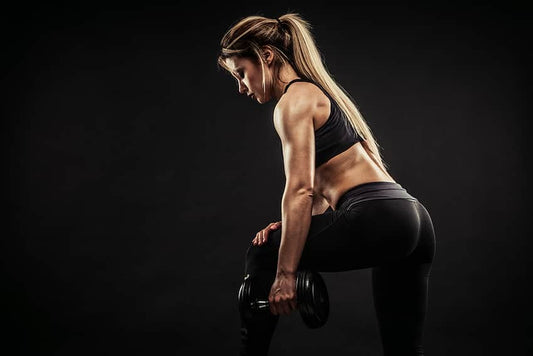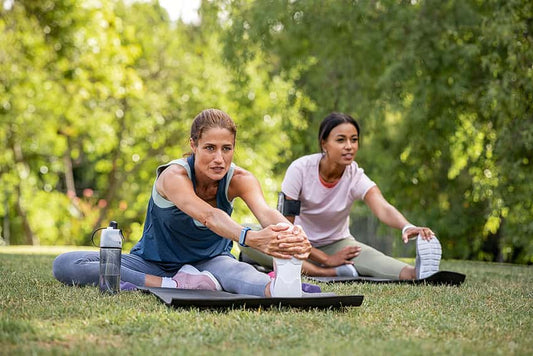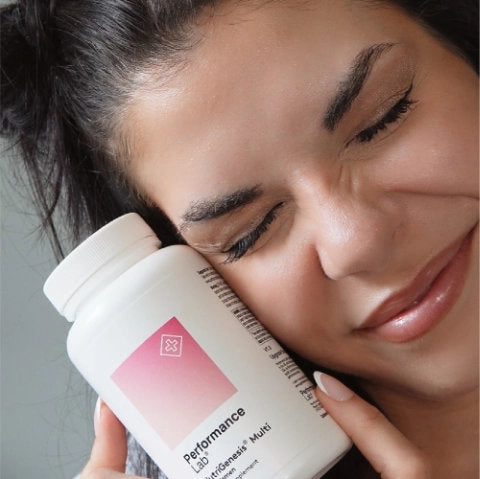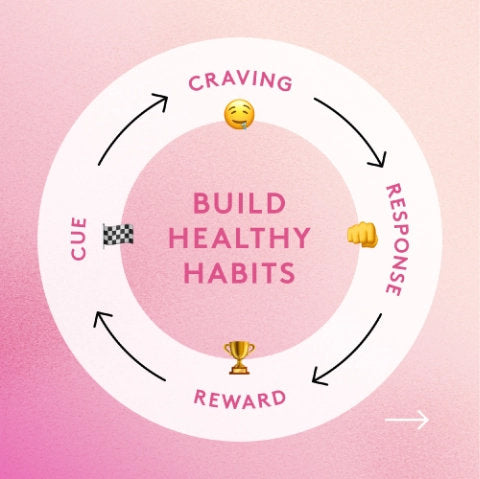Throwing on a pair of boxing gloves might be intimidating for anyone that’s never boxed before, but if you can overcome the fear of “not knowing what you’re doing,” a heavy bag is perhaps one of the best pieces of fitness equipment you can invest in.
While the most obvious benefit of heavy bag workouts is building your boxing or kickboxing skills—punches, kicks, elbows, knees—the heavy bag also offers many benefits for those who aren’t boxers.
They can improve your technique, build balance and coordination, boost muscle growth, enhance bone health, and give you an outlet for stress.
Heavy bag workouts aren’t just for the boxing pros, so grab your gloves and get ready to sweat—we’re walking you through the list of benefits linked to punching bag workouts.
What You Need To Know About The Heavy Bag
Heavy bags have been a staple of a boxer’s training program for decades, but there’s no concrete date when the hype started.
Simon D. Kehoe was the first person to patent the heavy bag in 1872, and since, it has become one of the most effective tools for training in various sports, not just boxing.
At first glance, the heavy bag is intimidating. It’s large, solid, and takes a fair bit of skill to knock out some impressive combinations.
In its essence, a heavy bag or punching bag is a sturdy cylindrical bag filled with various materials or suitable hardness designed to be punched.
The heavier and more material that fills the bag, the harder it is to punch. And there’s not just one type of punching bag—you’ll find speed bags, double-end bags, slip bags, heavy bags, uppercut bags, wall bags, and more.
With so many options, the workouts you can do are virtually endless. But if you have a heavy bag and are looking for a killer workout, here are the benefits you’ll get from working with one.
Benefits Of Heavy Bag Workouts
1. Improves boxing technique
Whether you’re a novice or professional boxer or have zero experience with the sport, throwing on a pair of boxing gloves and going at the punching bag is one of the best ways to learn and improve your boxing technique.
Boxing is about more than just throwing punches; it’s about executing each more with proper form, precision, and movement. You won’t make it past your opponent if you can’t master the basics—jab, cross, hook, and uppercut.
But these punches don’t come naturally to most people, which means practice makes perfect—and what better way to practice than on a heavy bag?
Unlike shadowboxing, a punching bag workout allows you to feel the force of impact when you land a punch, which can be helpful when contacting your opponent. And if the bag swings, it also allows you to work on your head and foot movement.
2. Improves power and strength
If you’ve ever done a heavy bag workout before, chances are your body has felt wobbly when you finish and incredibly sore a few days later. Unlike heavy weightlifting, boxing workouts incorporate muscles you probably never knew you had.
In addition to your prime movers, you’re also recruiting accessory muscles and stabilizers with every movement. When you’re not consistently working these muscles, they will be sore.
But by recruiting so many muscles in the upper and lower body and the core, you’re building strength and power.
While you may think boxing is primarily an upper body workout—and you will build boulder shoulders—you’re engaging all of the muscles in the chest, shoulders, back, legs, and core during a heavy bag session, making it an absolute killer full-body workout.
3. Boost endurance
Going hard on a heavy bag is no easy feat, and the extra challenge beyond you’re your body is used to will quickly whip your cardiovascular system into shape.
It will push you out of your comfort zone, make you work harder than you ever have, and steadily build your endurance over time. The more you push yourself, the more you’ll be able to endure over time.
You’ll see the positive benefits of punching bag workouts on other workouts, but also in your daily activities, such as walking or taking the stairs.
4. Improve coordination, balance, and stability
50% of boxing is throwing and countering, but the other 50% is about movement. If you watch a boxer, they are never still—they are always side-stepping, pivoting, slipping, and generally just moving. Standing still means getting hit.
And when you’re doing a punching bag workout, you want to constantly move around the bag and incorporate footwork to improve your technique. And in doing so, you’re improving your balance and coordination by getting into the right stance.
Plus, the weight transfer needed to successfully throw combination and move is also a great way to build balance and stability, which even transfers over to your lifts in the gym.
5. Decrease stress
There is certainly no shortage of benefits to breaking out the gloves and going at it on the bag, but perhaps the best reason to try a punch bag workout?
It’s a fantastic way to relieve stress. Punching bag workouts are great for improving your mood, decreasing feelings of anger, and relieving physical and mental stress.
Physically, exercise has many health benefits, but where your brain and nervous system are concerned, here’s what happens:
- Endorphins and endocannabinoids are released that play a role in pleasure, blocking the pain sensation and producing the euphoria associated with exercise 1, 2.
- Dopamine is released, which plays a primary role in the pleasure and reward system, but also regulates heart rate, mood, sleep, attention, motivation, memory, learning, and pain processing 3, 4.
- It promotes neuroplasticity of the brain and nervous system, which is essential for learning, activity, and language 5.
- Increases oxygen supply to the brain, improving executive function (memory, thinking, self-control) and protecting against cognitive decline 6, 7.
On a physical level, there’s nothing more satisfying for getting your stress out than hitting something—and hitting it as hard as you can.
When you’re feeling extra stressed, cortisol levels are high, which, over time, can take a serious toll on your health.
High cortisol affects sleep, brain function, energy levels, and appetite, but stress has also been linked to many nasty health conditions, including heart disease, diabetes, autoimmunity, and cardiovascular disease 8.
If your life feels chaotic, hop on the heavy bag and feel how much relief it brings.
Four Tips For Punching Bag Workouts
Ready to hit the bag? Here are some tips to maximize the benefits of your punching bag workouts!
1. Always wrap your hands
It should go without saying that if you’re going to spar, you want to wrap first. Although there are gloves available that don’t require wraps, they serve as an extra layer of protection and help to secure your gloves.
But if you’ve never wrapped your hands before, give yourself time before your workout—it can be a bit of a learning curve.
Punching bags are heavy and hard, and if your hands and wrists are not properly secure, you’ll increase the risk of injury.
2. Ensure you warm up
As with any exercise, you want to ensure your muscles are primed and ready to train—especially with boxing workouts.
A few minutes of skipping (or another cardio exercise) combined with shadowboxing is a traditional boxing warmup that helps to get your muscles warmed up and ready to punch.
3. Practice proper breathing techniques
Proper breathing is a major part of boxing—if you can’t breathe properly, you will fatigue fast. Inhaling during rest movements and exhaling during exertion allows oxygen to circulate to active muscle tissue and prevent fatigue.
4. Train with proper technique
Technique is everything in boxing. Although many people think boxing is about power and speed, it’s important to remember that technique always comes first.
As you gain skill and improve technique, speed and power come—but it’s not where your focus needs to be from the start. Poor technique means a higher risk of injury.
Final Thoughts
Heavy bag workouts are tough, but they’re worth your while, thanks to their impressive list of benefits.
Whether you’re looking to increase endurance, boost speed and power, or improve balance and coordination, you can do it with a punching bag workout.
And while it may be incredibly challenging at the moment, you’ll thank yourself later for pushing through.
- Chaudhry SR, Gossman W. Biochemistry, Endorphin. [Updated 2022 Apr 5]. In: StatPearls [Internet]. Treasure Island (FL): StatPearls Publishing; 2022 Jan-. Available from: https://www.ncbi.nlm.nih.gov/books/NBK470306/
- Basso JC, Suzuki WA. The Effects of Acute Exercise on Mood, Cognition, Neurophysiology, and Neurochemical Pathways: A Review. Brain Plast. 2017;2(2):127-152.
- Juárez Olguín H, Calderón Guzmán D, Hernández García E, Barragán Mejía G. The Role of Dopamine and Its Dysfunction as a Consequence of Oxidative Stress. Oxid Med Cell Longev. 2016;2016:9730467.
- Sonne J, Goyal A, Lopez-Ojeda W. Dopamine. [Updated 2022 Jul 4]. In: StatPearls [Internet]. Treasure Island (FL): StatPearls Publishing; 2022 Jan-. Available from: https://www.ncbi.nlm.nih.gov/books/NBK535451/
- Hötting K, Röder B. Beneficial effects of physical exercise on neuroplasticity and cognition. Neurosci Biobehav Rev. 2013;37(9 Pt B):2243-2257.
- Kleinloog JPD, Mensink RP, Ivanov D, Adam JJ, Uludağ K, Joris PJ. Aerobic Exercise Training Improves Cerebral Blood Flow and Executive Function: A Randomized, Controlled Cross-Over Trial in Sedentary Older Men. Front Aging Neurosci. 2019;11:333.
- Meng Q, Lin MS, Tzeng IS. Relationship Between Exercise and Alzheimer’s Disease: A Narrative Literature Review. Front Neurosci. 2020;14:131.
- Mariotti A. The effects of chronic stress on health: new insights into the molecular mechanisms of brain-body communication. Future Sci OA. 2015;1(3):FSO23.














